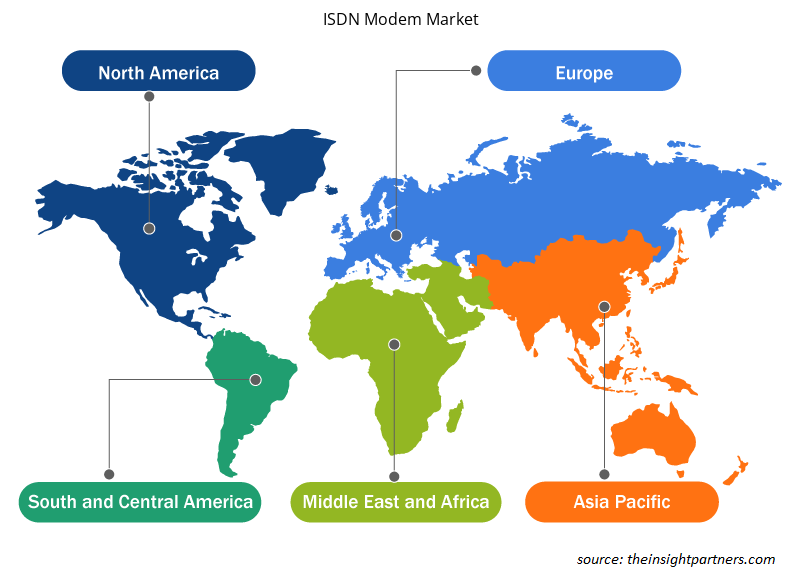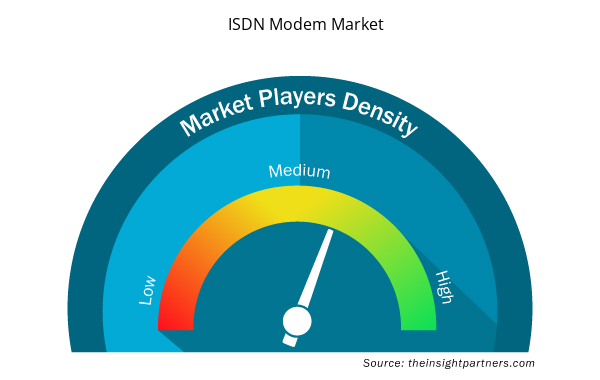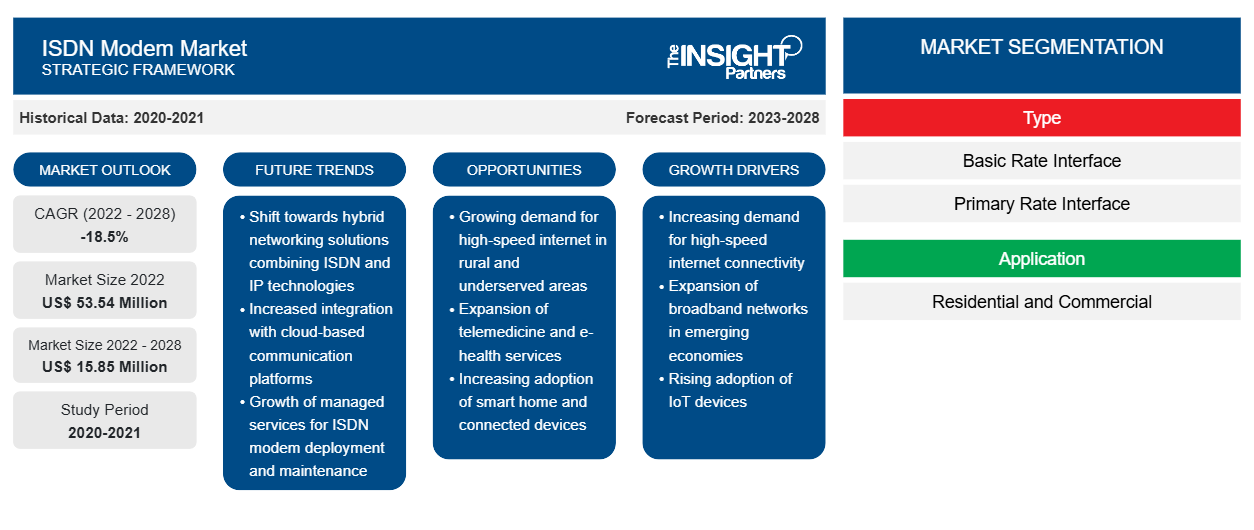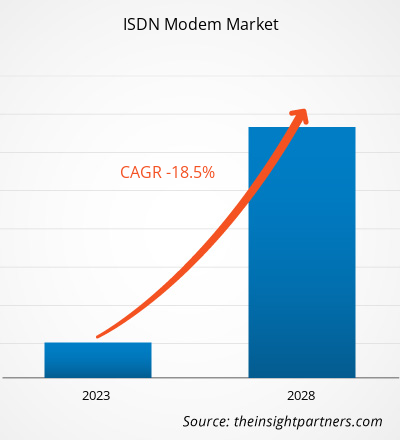Si prevede che il mercato dei modem ISDN passerà da 53,54 milioni di dollari USA nel 2022 a 15,85 milioni di dollari USA entro il 2028; si stima che registrerà un CAGR del -18,5% dal 2022 al 2028.
L'industria ISDN è iniziata negli anni '80 presso i Bell Labs ed è stata commercializzata nel 1988, insieme ai suoi standard. Le aziende che operavano in tutto il mondo in quell'epoca avevano sfruttato appieno le linee ISDN per le loro operazioni. Tuttavia, entro il 2000, diversi paesi hanno iniziato a muoversi verso tecnologie aggiornate che hanno fornito loro una velocità Internet più avanzata e moderne operazioni di telecomunicazione. Ad esempio, l'adozione di router a banda larga, Digital Subscriber Lines (DSL) e Asymmetrical Digital Subscriber Lines (ADSL) ha iniziato a sostituire le tecnologie dei modem ISDN in diverse regioni.
I modem ISDN sono più ampiamente disponibili delle tecnologie Digital Subscriber Line (DSL) e modem via cavo e sono ancora utilizzati come linea di backup quando la linea principale di una rete fallisce nei paesi sottosviluppati. Sono ampiamente utilizzati in applicazioni residenziali, come piccoli uffici domestici, per linee telefoniche aggiuntive e un buon servizio vocale. Inoltre, la crescita del mercato dei modem ISDN è stata principalmente guidata da diversi vantaggi come il trasferimento dati ad alta velocità durante le teleconferenze per supportare la crescente necessità di comunicazioni aziendali integrate tra le piccole imprese. Inoltre, le varie funzionalità del modem ISDN come l'inoltro di chiamata, la messa in attesa delle chiamate e l'ID chiamante hanno aumentato la preferenza per il modem ISDN come linee di backup in più aziende aziendali.
Personalizza questo report in base alle tue esigenze
Riceverai la personalizzazione gratuita di qualsiasi report, comprese parti di questo report, o analisi a livello nazionale, pacchetto dati Excel, oltre a usufruire di grandi offerte e sconti per start-up e università
- Scopri le principali tendenze di mercato in questo rapporto.Questo campione GRATUITO includerà analisi di dati che spaziano dalle tendenze di mercato alle stime e alle previsioni.
Inoltre, l'adozione del modem ISDN come linea di backup è stata osservata in paesi sottosviluppati come l'Etiopia. Ad esempio, a giugno 2021, Target Business Consultants Pvt. Ltd. Co., un'azienda con sede in Etiopia, ha acquistato circa 8 unità di modem ISDN in collaborazione con la MasterCard Foundation per un progetto COVID-19 implementato dalla Repubblica Federale Democratica d'Etiopia, Ministero dell'Innovazione e della Tecnologia (MInT). Tali casi hanno spinto la domanda di modem ISDN in tutta la regione africana.
La Broadband Integrated Services Digital Network (B-ISDN) è una rete virtuale a commutazione di circuito che può utilizzare servizi di commutazione di pacchetto elevati e un formato flessibile, ovvero la modalità di trasferimento asincrona, per la trasmissione dei dati. B-ISDN, una rete in fibra ad alta velocità, può funzionare a 100 Mbps, il che è ideale per applicazioni video, tra cui videosorveglianza e videoconferenza. Tuttavia, si prevede che la tecnologia B-ISDN verrà interrotta entro il 2025, il che limiterà le attuali dimensioni del mercato dei modem ISDN.
Impatto della pandemia di COVID-19 sul mercato dei modem ISDN
La pandemia di COVID-19 ha avuto un impatto grave su diversi settori, dalla produzione alle compagnie aeree. Tuttavia, ha influenzato positivamente il settore tecnologico a livello globale. Come misura di sicurezza, i governi di tutto il mondo hanno imposto il lavoro da casa per frenare la diffusione del virus COVID-19. A causa di tale misura governativa, molte aziende sono state pressate per adattarsi rapidamente al lavoro da remoto. In questa misura, diverse aziende hanno adottato Webex, Microsoft Teams e diversi metodi di comunicazione come gli smartphone. Invece di passare al VOIP sostituendo la comunicazione esistente, le aziende hanno optato per i suddetti metodi. Questo fattore ha avuto un impatto positivo sulle dimensioni del mercato dei modem ISDN, poiché molte aziende si sono astenute dal sostituire il sistema esistente con un nuovo sistema come il VoIP o altri servizi aggiuntivi tra cui ISDN. Inoltre, alcuni dei paesi con infrastrutture di telecomunicazioni povere come l'Etiopia hanno anche optato per i modem ISDN per le campagne nelle aree remote durante la pandemia di COVID-19. Ad esempio, a luglio 2021, la Repubblica Federale Democratica d'Etiopia, il Ministero dell'Innovazione e della Tecnologia (MInT) in collaborazione con la MasterCard Foundation avevano pubblicato un bando di gara per l'acquisto di 8 unità di modem ISDN per il rispettivo progetto COVID-19 in Etiopia. Tali casi hanno guidato il mercato durante l'anno fiscale 2020-2021.
Approfondimenti di mercato – Mercato dei modem ISDN
In base alla regione, l'analisi del mercato dei modem ISDN è principalmente segmentata in Nord America, Europa, Asia Pacifico, Medio Oriente e Africa e Sud America. Si prevede che il Nord America dominerà il mercato con una quota di mercato dei modem ISDN maggiore nel 2022 e si prevede che manterrà il suo predominio durante il periodo di previsione, seguito da Europa e Asia Pacifico. Inoltre, il mercato dei modem ISDN nell'Asia Pacifico è attribuito alle crescenti esportazioni di terminali e adattatori ISDN da paesi come l'India. Inoltre, si prevede che anche l'India dominerà il mercato regionale dell'Asia Pacifico con una quota di mercato dei modem ISDN maggiore nel 2022.
Approfondimenti sulle applicazioni – Mercato dei modem ISDN
In base all'applicazione, l'analisi del mercato dei modem ISDN è segmentata in residenziale e commerciale. Si prevede che il segmento commerciale dominerà il mercato nel 2022. Inoltre, si prevede che il segmento manterrà il suo predominio anche durante il periodo di previsione. La crescita del mercato dei modem ISDN per il segmento commerciale è principalmente attribuita alla domanda di modem ISDN tra le aziende aziendali nei paesi con infrastrutture di telecomunicazioni scadenti come Messico, Venezuela e Paesi Bassi. Le aziende messicane hanno ancora utilizzato reti ISDN per le rispettive operazioni in cui la domanda di nuovi modem ISDN è soddisfatta da attori internazionali del mercato dei modem ISDN come Stati Uniti e Regno Unito.
Approfondimenti regionali sul mercato dei modem ISDN
Le tendenze regionali e i fattori che influenzano il mercato dei modem ISDN durante il periodo di previsione sono stati ampiamente spiegati dagli analisti di Insight Partners. Questa sezione discute anche i segmenti e la geografia del mercato dei modem ISDN in Nord America, Europa, Asia Pacifico, Medio Oriente e Africa e America meridionale e centrale.

- Ottieni i dati specifici regionali per il mercato dei modem ISDN
Ambito del rapporto sul mercato dei modem ISDN
| Attributo del report | Dettagli |
|---|---|
| Dimensioni del mercato nel 2022 | 53,54 milioni di dollari USA |
| Dimensioni del mercato entro il 2028 | 15,85 milioni di dollari USA |
| CAGR globale (2022 - 2028) | -18,5% |
| Dati storici | 2020-2021 |
| Periodo di previsione | 2023-2028 |
| Segmenti coperti | Per tipo
|
| Regioni e Paesi coperti | America del Nord
|
| Leader di mercato e profili aziendali chiave |
|
Densità dei giocatori del mercato dei modem ISDN: comprendere il suo impatto sulle dinamiche aziendali
Il mercato dei modem ISDN sta crescendo rapidamente, spinto dalla crescente domanda degli utenti finali dovuta a fattori quali l'evoluzione delle preferenze dei consumatori, i progressi tecnologici e una maggiore consapevolezza dei vantaggi del prodotto. Con l'aumento della domanda, le aziende stanno ampliando le loro offerte, innovando per soddisfare le esigenze dei consumatori e capitalizzando sulle tendenze emergenti, il che alimenta ulteriormente la crescita del mercato.
La densità degli operatori di mercato si riferisce alla distribuzione di aziende o società che operano in un particolare mercato o settore. Indica quanti concorrenti (operatori di mercato) sono presenti in un dato spazio di mercato in relazione alle sue dimensioni o al valore di mercato totale.
Le principali aziende che operano nel mercato dei modem ISDN sono:
- Echinope
- TERRATELA
- Patton LLC
- A TLC Srl
- Tecnologie Epygi LLC
Disclaimer : le aziende elencate sopra non sono classificate secondo un ordine particolare.

- Ottieni una panoramica dei principali attori del mercato dei modem ISDN
Epygi Technologies LLC, Polycom, Ekinops, Xiamen Yeastar Information Technology Co. Ltd. e HypermediaS sono tra i principali attori del mercato dei modem ISDN che operano a livello globale. Il mercato dei modem ISDN è altamente consolidato e ha attori e leader di mercato affermati.
Gli operatori del mercato dei modem ISDN si stanno concentrando principalmente sulla fornitura di servizi ai clienti a livello di paese sottosviluppato che operano ancora con l'infrastruttura tradizionale delle linee ISDN. Diversi paesi importanti hanno già sostituito le loro linee ISDN e Public Safety Data Network (PSDN) esistenti con sistemi Digital Subscriber Lines (DSL), Asymmetrical Digital Subscriber Line (ADSL), Wide Area Network (WAN) e Voice Over Internet Protocol (VoIP) per le rispettive operazioni. Inoltre, gli operatori del mercato dei modem ISDN esistenti si stanno concentrando sulla trasformazione delle loro offerte di prodotti per soddisfare le richieste del mercato e mantenere la loro posizione di mercato nei rispettivi settori.
- Analisi storica (2 anni), anno base, previsione (7 anni) con CAGR
- Analisi PEST e SWOT
- Valore/volume delle dimensioni del mercato - Globale, regionale, nazionale
- Industria e panorama competitivo
- Set di dati Excel



Report Coverage
Revenue forecast, Company Analysis, Industry landscape, Growth factors, and Trends

Segment Covered
This text is related
to segments covered.

Regional Scope
North America, Europe, Asia Pacific, Middle East & Africa, South & Central America

Country Scope
This text is related
to country scope.
Domande frequenti
Primary Rate Interface (PRI) segment is expected to hold a major market share of ISDN modem market in 2022
India, UK, and France are expected to register slow declining rate during the forecast period
The US is expected to hold a major market share of ISDN modem market in 2022
Asia Pacific is expected to decline at a slower rate in the ISDN modem market during the forecast period (2022-2028)
Deployment of B-ISDN systems
Epygi Technologies LLC, Polycom, Ekinops, Xiamen Yeastar Information Technology Co. Ltd., and HypermediaS are the key market players expected to hold a major market share of ISDN modem market in 2022
The global market size of ISDN modem market by 2028 will be around US$ 15.85 million
The estimated global market size for the ISDN modem market in 2022 is expected to be around US$ 53.54 million
Demand for Backup Line Across Underdeveloped Countries
Trends and growth analysis reports related to Electronics and Semiconductor : READ MORE..
The List of Companies - ISDN Modem Market
- Ekinops
- TERRATEL
- Patton LLC
- A TLC S.r.l.
- Epygi Technologies LLC
- Polycom
- Xiamen Yeastar Information Technology Co. Ltd.
- HypermediaS
- Aristel Networks
The Insight Partners performs research in 4 major stages: Data Collection & Secondary Research, Primary Research, Data Analysis and Data Triangulation & Final Review.
- Data Collection and Secondary Research:
As a market research and consulting firm operating from a decade, we have published and advised several client across the globe. First step for any study will start with an assessment of currently available data and insights from existing reports. Further, historical and current market information is collected from Investor Presentations, Annual Reports, SEC Filings, etc., and other information related to company’s performance and market positioning are gathered from Paid Databases (Factiva, Hoovers, and Reuters) and various other publications available in public domain.
Several associations trade associates, technical forums, institutes, societies and organization are accessed to gain technical as well as market related insights through their publications such as research papers, blogs and press releases related to the studies are referred to get cues about the market. Further, white papers, journals, magazines, and other news articles published in last 3 years are scrutinized and analyzed to understand the current market trends.
- Primary Research:
The primarily interview analysis comprise of data obtained from industry participants interview and answers to survey questions gathered by in-house primary team.
For primary research, interviews are conducted with industry experts/CEOs/Marketing Managers/VPs/Subject Matter Experts from both demand and supply side to get a 360-degree view of the market. The primary team conducts several interviews based on the complexity of the markets to understand the various market trends and dynamics which makes research more credible and precise.
A typical research interview fulfils the following functions:
- Provides first-hand information on the market size, market trends, growth trends, competitive landscape, and outlook
- Validates and strengthens in-house secondary research findings
- Develops the analysis team’s expertise and market understanding
Primary research involves email interactions and telephone interviews for each market, category, segment, and sub-segment across geographies. The participants who typically take part in such a process include, but are not limited to:
- Industry participants: VPs, business development managers, market intelligence managers and national sales managers
- Outside experts: Valuation experts, research analysts and key opinion leaders specializing in the electronics and semiconductor industry.
Below is the breakup of our primary respondents by company, designation, and region:

Once we receive the confirmation from primary research sources or primary respondents, we finalize the base year market estimation and forecast the data as per the macroeconomic and microeconomic factors assessed during data collection.
- Data Analysis:
Once data is validated through both secondary as well as primary respondents, we finalize the market estimations by hypothesis formulation and factor analysis at regional and country level.
- Macro-Economic Factor Analysis:
We analyse macroeconomic indicators such the gross domestic product (GDP), increase in the demand for goods and services across industries, technological advancement, regional economic growth, governmental policies, the influence of COVID-19, PEST analysis, and other aspects. This analysis aids in setting benchmarks for various nations/regions and approximating market splits. Additionally, the general trend of the aforementioned components aid in determining the market's development possibilities.
- Country Level Data:
Various factors that are especially aligned to the country are taken into account to determine the market size for a certain area and country, including the presence of vendors, such as headquarters and offices, the country's GDP, demand patterns, and industry growth. To comprehend the market dynamics for the nation, a number of growth variables, inhibitors, application areas, and current market trends are researched. The aforementioned elements aid in determining the country's overall market's growth potential.
- Company Profile:
The “Table of Contents” is formulated by listing and analyzing more than 25 - 30 companies operating in the market ecosystem across geographies. However, we profile only 10 companies as a standard practice in our syndicate reports. These 10 companies comprise leading, emerging, and regional players. Nonetheless, our analysis is not restricted to the 10 listed companies, we also analyze other companies present in the market to develop a holistic view and understand the prevailing trends. The “Company Profiles” section in the report covers key facts, business description, products & services, financial information, SWOT analysis, and key developments. The financial information presented is extracted from the annual reports and official documents of the publicly listed companies. Upon collecting the information for the sections of respective companies, we verify them via various primary sources and then compile the data in respective company profiles. The company level information helps us in deriving the base number as well as in forecasting the market size.
- Developing Base Number:
Aggregation of sales statistics (2020-2022) and macro-economic factor, and other secondary and primary research insights are utilized to arrive at base number and related market shares for 2022. The data gaps are identified in this step and relevant market data is analyzed, collected from paid primary interviews or databases. On finalizing the base year market size, forecasts are developed on the basis of macro-economic, industry and market growth factors and company level analysis.
- Data Triangulation and Final Review:
The market findings and base year market size calculations are validated from supply as well as demand side. Demand side validations are based on macro-economic factor analysis and benchmarks for respective regions and countries. In case of supply side validations, revenues of major companies are estimated (in case not available) based on industry benchmark, approximate number of employees, product portfolio, and primary interviews revenues are gathered. Further revenue from target product/service segment is assessed to avoid overshooting of market statistics. In case of heavy deviations between supply and demand side values, all thes steps are repeated to achieve synchronization.
We follow an iterative model, wherein we share our research findings with Subject Matter Experts (SME’s) and Key Opinion Leaders (KOLs) until consensus view of the market is not formulated – this model negates any drastic deviation in the opinions of experts. Only validated and universally acceptable research findings are quoted in our reports.
We have important check points that we use to validate our research findings – which we call – data triangulation, where we validate the information, we generate from secondary sources with primary interviews and then we re-validate with our internal data bases and Subject matter experts. This comprehensive model enables us to deliver high quality, reliable data in shortest possible time.


 Ottieni un campione gratuito per questo repot
Ottieni un campione gratuito per questo repot